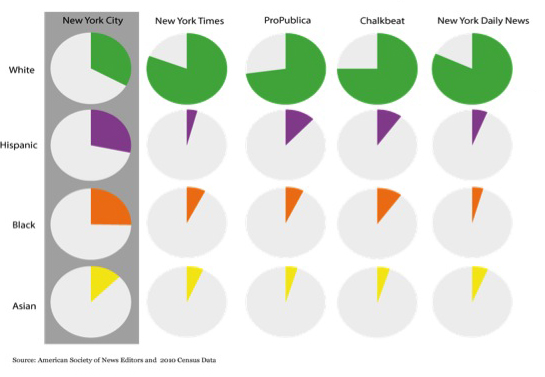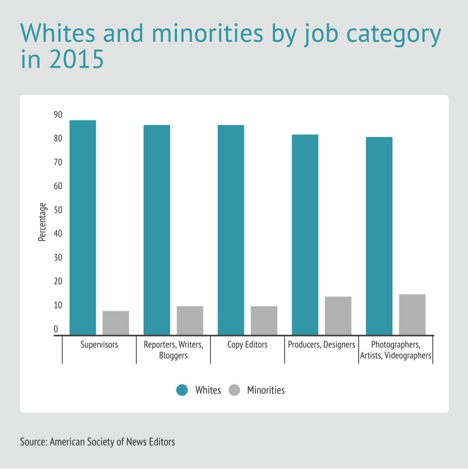When John Henry joined the New York Daily News four decades ago, he worked in a bubble. Women were few in the newsroom, and journalists of color were even fewer. The staff was dominated by an overwhelming majority of white men, and diversity was the least of anyone’s worries.
“It was a period of declining circulation, and I think [the Daily News] was just sort of trying to stem the tide of red ink,” Henry says. As for bringing on new voices or perspectives from outside the white male bubble, he adds, “They probably weren’t doing that much hiring.”
Over a long career at the New York tabloid, Henry saw firsthand how a monolithic newsroom narrowed his newspaper’s editorial purview.
“Every different group brings something new and valuable,” he says. “That’s why it’s so important. And it can also establish rapport with people with a particular background that an outsider can’t.”
Newsrooms have addressed the issue in fits and starts over recent decades, but those efforts have stagnated in the past 10 years. In fact, the portion of newsrooms made up of people of color has actually ticked downward one percentage point during this period, according to the American Society of News Editors, from nearly 14 percent to less than 13 percent.
The lack of long-term change in this regard stems at least in part from media-wide apathy. But it’s a question of resources as well, especially in the face of the industry’s daunting financial prospects. How do you hire a staff that includes people of different races, genders, and experiences?
1. Acknowledge there is a problem
The map above uses ASNE data to estimate statewide averages for the proportion of newsroom employees who are people of color. ASNE reports define diversity by gender and race (American Indian, Asian American, Hispanic, black, and multi-racial). To be sure, this measure excludes socioeconomic status, education, age, and sexual orientation—all factors that contribute to a diversity of perspectives. But the data provide a good starting point for coming to grips with reality.
“Diversity for me means your ability to capture and engage all of the communities that you are covering,” says ASNE Executive Editor Teri Hayt. “You have to have people that understand the language intimately–and not just verbally, but also written in a particular regard. Having those people that have that life experience that can tell that story [is paramount].”
Participation in ASNE’s diversity report is optional, so overall results are potentially skewed. ASNE uses data from newspapers that returned the survey to project the numbers for non-responding newspapers in the same circulation range.
Notably, the projections show states with the most collectively diverse newsrooms still average less than 50 percent minorities among working journalists. Narrowing the lens to New York City, the disparities between media companies and local populations become even more obvious. There’s no way to spin the data.

Breaking down job categories by race is equally telling: Journalists of color hold less than 10 percent of leadership roles, where major editorial decisions are made. Encouraging various perspectives in the newsroom fosters an environment of distinct ideas and stories that may ultimately help attract a broader readership. But before hiring for diversity, news organizations must first acknowledge that there is a problem.

2. Consciously work to overcome barriers to entry
How do you find reporters with varying perspectives? This is a challenge for legacy and digital companies alike. It’s easy to hire young journalists with better access to higher education, the means to take on unpaid internships, and far-reaching social networks. And those journalists are typically white.
Betsy Wade, the first female copy editor at The New York Times, says companies have to put in the work to close the gaps in skills and groom individuals of color who have potential.
“For a while, the education of [minority journalists] had been neglected at each stage of the game,” Wade says. “So in order to prepare them for the newsroom, it’s going to cost news organizations extra training, extra time, and extra effort.”
In a 2015 manifesto on diversity, Stephanie Foo stresses the need for organizations to step outside their comfort zone when hiring. She mentions NPR’s Snap Judgement, which places job postings on Craigslist. It’s a unique way to attempt to open the pipeline for nontraditional candidates.
Below, Daniel Alarcón, founder of Radio Ambulante, a podcast with a focus on Latin American stories, and Philip Lewis, an African-American staff writer at Mic, share their perspectives on barriers to entry in the journalism industry.
3. Tell stories minorities want to read
There has been a rise in the number of diversity-minded sites and editorial initiatives, including Fusion, Vox’s “Identities” vertical, and HuffPost Black Voices, in additional to the general rise of first-person, identity-driven essays as a digital-friendly form. Pursuing unique story angles on race and gender has also become a growing focus of many news organizations.
“Our purpose is to protect people who can’t protect themselves, and to tell their stories, and to make situations better for them by fighting the powers that be and illuminating the injustices that exist,” says Wilbert Cooper, a senior editor at Vice who is African-American.
Fusion has incorporated diversity into its mission statement: “At Fusion, we champion a young, diverse, and inclusive America from the inside out. We approach news and entertainment through a lens that celebrates all voices in today’s world.” In the wake of the mass shooting at a gay club in Orlando last weekend, Fusion’s coverage included a writer’s personal reflection on the venue—“my safe haven”—and a column titled, “It’s not safe to be a queer person in America.”
Of course, diversity of coverage has not solved all of Fusion’s business or editorial challenges—it’s no silver bullet. But the outlet’s concerted effort to pursue such stories certainly makes it a more attractive landing spot for minority journalists.
4. Focus on retention
Hiring with diversity in mind is just the beginning. Keeping minority journalists on board can be even more challenging. The retention rate for white journalists in 2015 was 86 percent across the industry, according to ASNE data, compared to 78 percent for journalists of color. This discrepancy contributes to the racial imbalance in leadership positions over time.
Jelani Cobb, a New Yorker writer who often covers race, says that the prevalence of mostly white news institutions perpetuates itself. He argues that self-interest alone should be enough reason for publications to want to get diverse voices and keep them. “There are stories that you miss out on, stories that you could really get good readership for and circulation for that you don’t get if those voices are not at the table,” Cobb tells CJR.
A lack of diversity can also prove a turn-off for women reporters or journalists of color, as they may be shoehorned into covering specific topics by default. When black journalist Randy Archibold was covering the Los Angeles riots in 1992, he said, “Suddenly [I was] the spokesman for what was going on in LA at the time.* I grew up in New Jersey in a middle class suburb. I was not from South Central, but suddenly I was called upon to speak of the struggles of inner city LA.”
More diverse staffs, adds Archibold, now deputy sports editor at The New York Times, can prove a selling point for attracting and retaining yet more diverse points of view. A number of large news organizations, such as The New York Times, BuzzFeed, The Wall Street Journal, and others, have initiated programs to jumpstart such ventures. But financial pressures have hampered these and other efforts at far more outlets.
In 1978, ASNE set a goal of increasing diversity within newsrooms to match that of the population by 2025. But it acknowledged in a press release last year that the lofty mission might not be accomplished. Let’s hope the organization is wrong, and that the increasing diversity of media—from old platforms like newspapers to new platforms like Snapchat—can be matched by that of the journalists who work there.
*This story was updated to the correct spelling of Randy Archibold’s name.
This multimedia piece was produced by Carlett Spike, Isabella Kulkarni, Jephie Bernard, Ellen Francis, and Samantha McDonald, all 2016 graduates of the Columbia Journalism School.
The Editors are the staffers of the Columbia Journalism Review.

